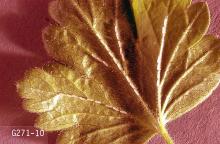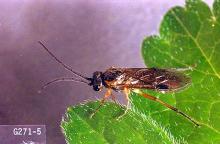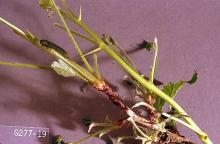Nematus ribesii
Pest description and crop damage Adults are black sawflies about 8-9 mm in length with light yellow marks on the abdomen. Larvae initially are small and white, but full-grown larvae are about 12 mm long and greenish, often with dark body spots, especially when partially grown. Sawflies are in the insect order Hymenoptera but their larvae resemble a lepidopteran caterpillar. Larvae feed along leaf margins and, when numerous, may defoliate the entire plant within a few days.
Biology and life history The insect overwinters in a capsule-like cocoon on the soil surface or just below. The adult sawfly emerges in April to coincide with leaf emergence, and lays eggs on the underside of the leaves, often toward the center of the plant. The eggs hatch, and the young larvae feed on the leaves for 2 to 3 weeks, then drop to the soil and pupate. The second-generation larvae are active beginning about harvest, usually sometime in July. These larvae drop to the ground to overwinter.
Scouting and thresholds In April, inspect plants daily for signs of larval feeding. This will appear as small holes in the center of leaves, often near the middle of the plant.
Management-cultural control
Home gardeners: Pick off infested leaves and destroy larvae. Remove and destroy badly infested canes.
Management-chemical control: HOME USE
No products are registered for control of this pest in home gardens.
Management-chemical control: COMMERCIAL USE
Note: The effectiveness of spinetoram and spinosad for controlling this pest has not been determined; but, as they control a wide range of insects, they may also be effective for controlling the imported currant worm.
- fenpropathrin (Danitol 2.4EC) at 0.2 to 0.3 lb ai/A. PHI 21 days. Do not exceed 0.8 lb ai/A per season. Do not apply during bloom. Restricted use pesticide.
- malathion-Consult label for rate. PHI 1 day. Apply in 100 gal/A water. Toxic to bees; do not use when bees are foraging. Also toxic to fish and other aquatic invertebrates.




